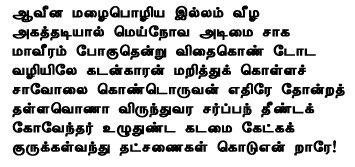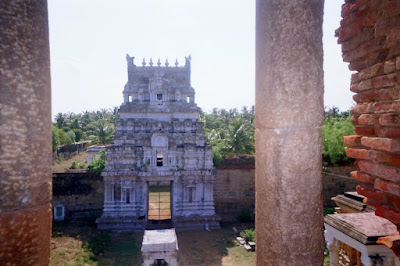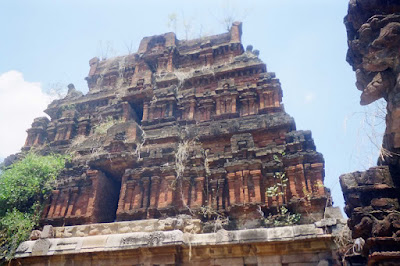So what is the speciality of Periazhwar, that he is one of the most revered of Azhwars.
- First, he has sung great songs in praise of Lord Vishnu
- Second, he found Aandaal, Goddess Lakshmi incarnate, as a child in the garden and brought her up. Aandaal is the only female Azhwar.
- Third, As a result of giving his daughter Aandaal in marriage to Lord Ranganathar at Srirangam, he became the father-in-law for Lord Vishnu, which no other Azhwar has attained.
- He was the reason for the practice of submitting yearly accounts of Srirangam temple to Srivillipuththoor temple. This is as if Lord Vishnu showing the expenses to his wife Aandaal and the Srivillipuththoor temple. Even today, it is celebrated as a festival.
Now lets get into his songs. So whats, special about his songs? If you read the other Azhwars' songs, all of them would have sung the songs in praise of the Lord. But Periazhwar goes one step further and bless Lord Vishnu. Here goes his Pasurams.

"Pallaandu Pallaandu Pallaayirathaandu
Palakodi Nooraayiram
Mallaanda ThinnThol Manivanna Unn
Saevadi Sevvi Thirukkaapu"
meaning, Long live Lord Vishnu for many crores and hundreds of thousands of years. And the Lotus feet shine and be protected for the above mentioned years of the great person with mighty and powerful shoulders.
Pallaandu - Many years
Pallayiram - Many thousands
Aandu - Years
Palakodi - Many Crores
Nooraayiram - 100,000
Mallaanda - Wrestling
ThinnThol - Strong and might shoulders
Manivanna - another name of Lord Vishnu
Saevadi - Lotus Feet
Sevvi - Shine, being red in colour
Thiru - Divine
Kaapu - Protection
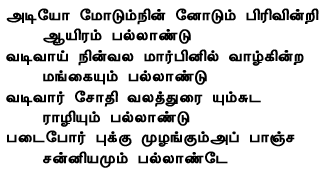
"Adiyodum Ninnodum Pirivindri
Aayiram Pallaandu
Vadivaai Ninnvala Maarbinil Vaazhkindra
Mangayum Pallaandu
Vadivaar Jodhi Valaththuraiyum
Sudaraazhiyum Pallaandu
Padaipore Pukku Muzhangum
Appaancha Channiyamum Pallaandae"
meaning, Let me stay at Your Lotus feet, with You and without separation for Thousands of years. Thousands of years to Goddess Lakshmi who resides in right side of your chest. Thousands of years to the Sudharshana Chakra (Sakkarathaazhwar) who resides on Your right shoulder. Thousands of years to the Panchachanniyam (Conch), that sounds when You go into battles.
The above songs are a proof of why Periazhwar is venerated so much. No other azhwar has attempted or even thought of blessing The Lord himself. By doing so he positions himself as a parent, which apparently he became after giving his daughter in marriage to the Lord. There are 12 such blessings Paasurams. These Paasurams are being sung as a hymn in all Vaishnavaite temples during the Vaigunda Yaegaadhasi, Bramhothsavam and other auspicious events.
Another masterpiece of Periazhwar are the Paasurams that is believed to cure any disease when sung regularly.
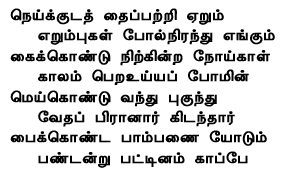
"Neikudathai Patri Yaerum Yerumbugal
Pol Nirandhu Yengum
Kaikondu Nirkindra Noigaal
Kaalam Pera Uyiaa Pomin
Meikondu Vandhu Pugundhu
Vedha Piraanaar Kidandhaar
Paikkonda Paambanai Yodum
Pandandru Pattinam Kaapae"
meaning, To all the diseases that crowd my body as the ants (as a colony) that climb and cover the ghee pot and be spread all over it. If you want to survive, get out of my body immediately. The Lord of the Vedhas has entered my body bringing with Him the Truth and is residing in my body. The Lord inhabiting my body with his snake bed, makes my body like a fortified city. So all diseases get out of my body.
This way, he warns, intimidates and even pleads the disease to leave the body. People believe and have even said that they got their diseases cured on chanting the Paasurams.
Periazhwar, as his name suggests, is a great man who has won the heart of the God himself, by his devotion and his Paasurams and of course bringing up a child who also became an Azhwar. That is simply a great achievement. His works will live Pallaandu till time and space exist.
More to come, until then...























